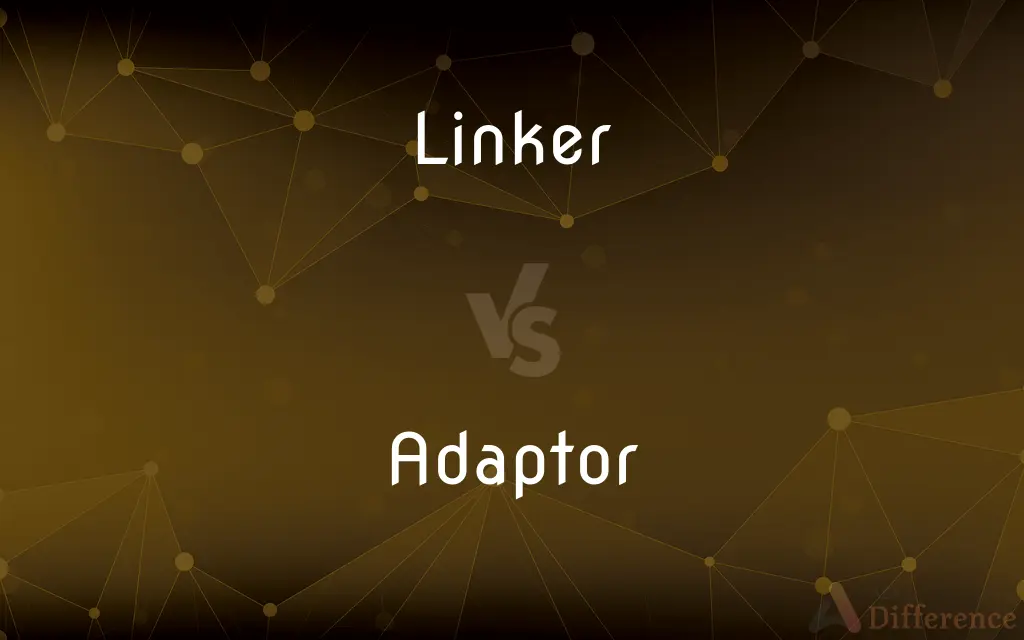Linker vs. Adaptor — What's the Difference?
Edited by Tayyaba Rehman — By Maham Liaqat — Updated on April 17, 2024
Linkers are sequences in DNA cloning that provide a site for enzyme recognition and ligation, while adapters are short sequences or molecules that join two other molecules or sequences together, often used in molecular biology and data transmission.

Difference Between Linker and Adaptor
Table of Contents
ADVERTISEMENT
Key Differences
In the context of molecular biology, linkers are synthetic DNA sequences that are designed to incorporate specific restriction enzyme sites, facilitating the insertion of foreign DNA into vector sequences, while adapters in molecular biology are usually short, synthesized oligonucleotides that connect DNA fragments to other molecules or surfaces, such as sequencing platforms.
Linkers are used to add flexibility or space between two domains of a protein or two parts of a molecule, enhancing the functionality or stability, whereas adapters can serve as intermediaries that allow incompatible elements to work together, such as connecting sequencing libraries to sequencing instruments.
In terms of data communication, a linker is a software that combines multiple object files into a single executable or library, resolving symbol references, while an adapter in this context refers to hardware or software that allows devices or programs to communicate despite having different interfaces.
Linkers often perform critical roles in the assembly of complex molecules or macromolecular structures in synthetic chemistry and biotechnology, while adapters are crucial in systems integration, where different physical, logical, or protocol interfaces need to be bridged.
The specificity of linkers to include certain enzyme recognition sites makes them essential for precise genetic engineering tasks, whereas adapters, by their nature, are designed to be versatile and are used in a wide range of applications from electronics to software development.
ADVERTISEMENT
Comparison Chart
Function in Biology
Incorporates restriction sites for DNA insertion
Connects DNA fragments to other molecules or surfaces
Usage in Technology
Combines object files into a single executable
Allows devices or programs with different interfaces to communicate
Role
Adds flexibility or space between molecule parts
Serves as an intermediary for compatibility
Specificity
Specific to enzyme recognition sites
Designed for versatility across various systems
Primary Context
Molecular biology, synthetic chemistry
Molecular biology, data communication, systems integration
Compare with Definitions
Linker
Often synthetic and designed to include specific features like enzyme recognition.
Synthetic linkers are used in protein engineering to maintain domain integrity.
Adaptor
Can be both hardware and software, depending on the application.
The company integrated a software adapter to streamline data transfer between different platforms.
Linker
Critical in constructing recombinant DNA by joining DNA pieces.
Using a linker, the geneticist connected two genes of interest in a new vector.
Adaptor
A device or software that enables connections between different systems.
An adapter was used to connect the USB-C device to the USB-A port.
Linker
A sequence or substance used to connect two structures, such as DNA fragments.
The researcher added a linker with a HindIII site to facilitate cloning.
Adaptor
Bridges the gap between incompatible technologies or formats.
The video software required an adapter to import older file types.
Linker
Provides necessary spacing or orientation in molecular assemblies.
The chemical synthesis involved a flexible linker to improve the molecule's stability.
Adaptor
In molecular biology, a short sequence that facilitates the attachment of DNA fragments to other elements.
Adapters were ligated to DNA fragments for next-generation sequencing.
Linker
In computing, a program that combines multiple object files into a single executable.
The software developer used a linker to resolve external references in the program.
Adaptor
Enhances the functionality of devices by allowing for additional capabilities.
The network adapter enabled the computer to connect to wireless internet.
Linker
One of the rings or loops forming a chain.
Adaptor
Variant of adapter.
Linker
A unit in a connected series of units
Links of sausage.
One link in a molecular chain.
Adaptor
Alternative form of adapter
Linker
A unit in a transportation or communications system.
Adaptor
Device that enables something to be used in a way different from that for which it was intended or makes different pieces of apparatus compatible
Linker
A connecting element; a tie or bond
Grandparents, our link with the past.
Linker
An association; a relationship
The Alumnae Association is my link to the school's present administration.
Linker
A causal, parallel, or reciprocal relationship; a correlation
Researchers have detected a link between smoking and heart disease.
Linker
A cufflink.
Linker
A unit of length used in surveying, equal to 0.01 chain, 7.92 inches, or about 20.12 centimeters.
Linker
A rod or lever transmitting motion in a machine.
Linker
(Computers)A graphical item or segment of text in a webpage or other electronic document that, when clicked, causes another webpage or section of the same webpage to be displayed
That newspaper's homepage includes links to numerous government resources. Also called hotlink, hyperlink.
Linker
To put together physically, as with links
Linked the rings to form a chain.
Linker
To connect, relate, or associate
Linked the suspect to the crime.
Linker
To make or have a link to (another webpage or electronic document)
The blog links important news stories from across the web.
Linker
To make a link in (a webpage or electronic document)
The teacher linked the class website to an online map.
Linker
To be or become joined together physically
The molecules linked to form a polymer.
Linker
To be or become connected, related, or associated
Their business has linked up with ours.
Linker
To make or have a link to a webpage or electronic document
The shocking news story was linked to by many blogs. The article linked to photos of the damage.
Linker
To follow a link in a webpage or electronic document
With a click of the mouse, I linked to the museum's website.
Linker
That which links.
Linker
(compilation) A computer program that takes one or more objects generated by compilers and assembles them into a single executable program.
Linker
(genetics) A short oligonucleotide containing a recognition sequence for a restriction enzyme, used to blunt the ends of sticky DNA segments.
Linker
(grammar) A word or short expression that links clauses or other syntactic elements.
Linker
A linked bond, one for which the principal is indexed to inflation.
Linker
(genetics) To ligate a DNA segment using a linker.
Common Curiosities
What types of adapters are commonly used in electronics?
In electronics, common adapters include those for converting between different types of electrical connectors, such as USB, HDMI, and power adapters.
How do adapters function in next-generation sequencing?
In next-generation sequencing, adapters are ligated to DNA fragments to allow them to bind to the sequencing platform, facilitating the sequencing process.
Can linkers affect the performance of a molecule or assembly?
Yes, the properties of a linker, such as its length and flexibility, can significantly affect the stability, orientation, and function of the molecular assembly.
What is the primary purpose of a linker in DNA cloning?
In DNA cloning, the primary purpose of a linker is to introduce specific restriction enzyme sites that facilitate the insertion of DNA fragments into vectors.
Can linkers be used in software applications?
In software, linkers are not used as physical entities but as programs that combine multiple object files into a cohesive executable.
How do adapters improve system integration?
Adapters improve system integration by enabling communication and functionality between otherwise incompatible systems, devices, or software.
How do linkers and adapters differ in their application in biotechnology?
In biotechnology, linkers are specifically used to join DNA sequences with desired properties, while adapters are used to attach DNA or other molecules to various platforms or carriers.
Are there any risks associated with using linkers or adapters?
The risks mainly involve compatibility issues, such as using the wrong linker or adapter for a particular purpose, which can lead to failures in experiments or device malfunctions.
What is a common example of a linker in chemistry?
In chemistry, a common example of a linker is a polyethylene glycol (PEG) chain used to connect two protein molecules or other macromolecular structures.
What should be considered when choosing an adapter for a technological setup?
Considerations include the specific requirements of the device interfaces, power requirements, and the quality and reliability of the adapter to ensure efficient and safe operation.
Share Your Discovery

Previous Comparison
Measurement vs. Evaluation
Next Comparison
Afternoon vs. EveningAuthor Spotlight
Written by
Maham LiaqatEdited by
Tayyaba RehmanTayyaba Rehman is a distinguished writer, currently serving as a primary contributor to askdifference.com. As a researcher in semantics and etymology, Tayyaba's passion for the complexity of languages and their distinctions has found a perfect home on the platform. Tayyaba delves into the intricacies of language, distinguishing between commonly confused words and phrases, thereby providing clarity for readers worldwide.














































